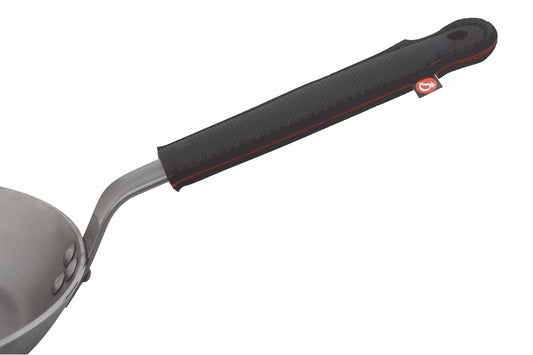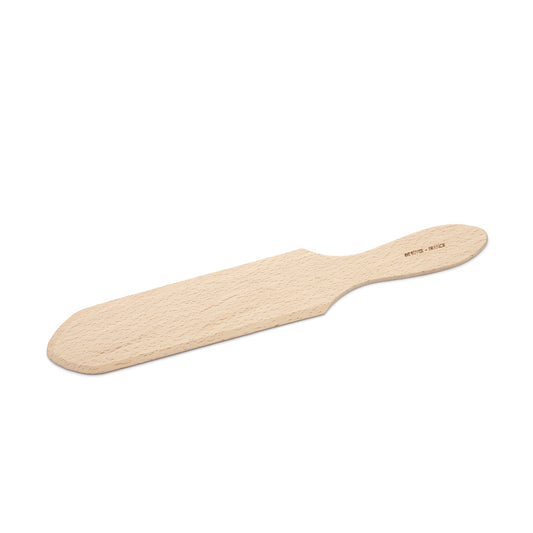What is a Wok? More Than Just a Bowl-Shaped Pan
Discover what makes a wok essential in the kitchen, from its unique shape and materials to its 3,000-year history and unmatched versatility in cooking.
de Buyer

From pad thai to prawn fried rice to crispy duck, some meals are best prepared in a wok. This high-heat cookware is more than just a large bowl-shaped pan, and at de Buyer, we've spent years developing an appreciation for and a mastery of wok cooking.
We respect culinary heritage and are committed to offering quality cookware for diverse cooking styles. This article will explore what exactly a wok is, including its rich history and the reason for its enduring popularity.
Defining the Wok: Form and Function
Unlike the traditional frying pan or dutch oven, you may not find this cooking pot in many culinary stores. Its unique form and exact function are unfamiliar to many accomplished home cooks.
The Distinctive Shape
The sizzle in a wok is a promise of a fragrant dish. The wok's ability to create fantastic meals comes from its distinctive shape. Its sloping sides, sturdy handles, classic round bottom, and wide circular construction are well-suited to flash-cooking delicious meals.
The heat is easily distributed up the sloping sides, especially when cooking over an open flame. Cooks can toss food freely in the deep pot, cooking along the bottom half of the pan and moving food up the sides to keep it warm.
There are flat-bottomed variations that are designed for cooking on induction and electric stoves. Flat-bottomed woks are a fine option for those without access to open-fire cooking or even a gas stove.
Common Materials
The traditional wok materials are carbon steel and cast iron. These materials are well-suited to wok cooking due to their heat retention capabilities. In recent years, modern alternatives like stainless steel have been used due to their quick heat response and lightweight construction.
- MINERAL B Carbon Steel Wok: Durable carbon steel construction offers excellent heat distribution for wok cooking, developing a natural non-stick patina with use. Curved sides support easy tossing and even cooking—an essential for home cooks and chefs crafting Asian-inspired dishes.
- Blue Carbon Steel Wok: A 12.5" high-performance wok ideal for cooking large portions with even heat, perfect for wok cooking. Made from blue carbon steel for rapid heating and natural non-stick seasoning, it features ergonomic handles and works on all cooktops.
Chefs typically use mild and neutral oils to cook in a wok, like peanut oil, grapeseed oil, or avocado oil. However, a natural patina may limit the need for oils. When seasoned properly, woks made with cast iron or carbon steel have a naturally non-stick surface, minimizing the need for cooking oil.
Key Features
Most woks have a single long handle. This allows cooks to shake the wok over the flame without getting too close to the fire. In some woks, there is an additional ‘helper handle.’ This is a shorter handle attached to a pan on the opposite side of the long handle. It’s used for extra stability and control when lifting a full wok. A full wok can be extremely heavy and may require the strength of two people to lift. This is also when a helper handle is useful.
The classic round-bottomed wok is typically around 12 - 13 inches wide. This provides enough space for cooked rice, proteins, and veggies, all cooking at once. They're also adaptable; when paired with a rack and cover, a classic wok can function like a bamboo steamer.
A Culinary Journey Through Time: The History of Wok Cooking
From the karahi—a deep, circular South Asian cooking pot—came the wok. The karahi was heavier and deeper, more associated with long cook times and prized for its ability to retain heat. Woks developed from the karahi to be lighter and more adept at quick, medium-high heat cooking. They were originally crafted for use on Chinese stoves fueled by wood or charcoal.
These woks have been a staple of Chinese cooking for around 3,000 years. Early Chinese cooks prized the woks' fuel efficiency and ability to cook different foods in one single pan. The wok was traditionally used for techniques like stir-frying, boiling, braising, poaching, and stewing. By far, the most popular cooking method was stir-frying.
From this method came the phrase 'wok hei,' meaning the 'breath of a wok.' Wok hei refers to the classic taste that proper wok cooking achieves. With practice, any budding or seasoned chef can eventually master wok hei. Achieving wok hei involves intense heat, caramelization, Maillard reactions, and smoking oil. A seasoned wok’s patina adds to this signature flavor, creating dry, seared surfaces with a deep, complex aroma.
There are many wok adaptations and regional variations across Asia, including:
- Wajan: An Indonesian wok-like pan; wajan derives from the Javanese, meaning “steel.” Used for stir-frying and deep-frying.
- Kawah: This is a Malaysian cookware item. It's a large wok often used for big batches or communal cooking.
- Kazan: A heavy, cauldron-like pot used for stews, pilafs, and communal dishes throughout Central Asia.
Through immigration and trade, woks slowly spread to the Western world where they were primarily associated with stir-frying and Asian cuisine. In the 1800s, Chinese immigrants brought traditional woks to the United States.
These immigrants invented American Chinese cooking, which included meals like chop suey and chow mein. These dishes were still prepared in a wok but were not traditional Chinese meals. Instead, these dishes were created to appeal to the American palate and the desire for Chinese flavors.
New chefs experimented with wok cooking using North American and Western foods. Wok chefs learned to deep fry chicken and achieve a desirable golden brown sear on steak. The popularity of wok cooking spread with the combination of exposure and innovation.
The Wok’s Enduring Appeal
From carbon steel woks to cast iron woks to stainless steel woks, the appeal of wok cooking remains the same.
- Versatility Beyond Stir-Frying: As mentioned, woks aren’t just for stir-frying. You can use them for steaming, deep-frying, braising, and even smoking (using foil, a rack, and wood chips).
- Efficiency and Speed: Wok heat can cook food quickly and evenly. You may treat it like a large frying pan. Some people may use woks for cooking stews, but they’re truly best with high-heat cooking.
- Cultural Significance: The wok is a cultural icon in many Asian societies. Using a wok for high-heat cooking is a way for many to connect with or show appreciation for cultural culinary backgrounds.
Your regular frying pan and oven roasting pan can only do so much, and a wok is a needed addition to any kitchen. It creates unique, delightful flavors, and mastering the wok is an enjoyable, tasty process. Use a wok to experiment with fantastic meals and properly explore Chinese cuisine.
Using a Wok in Your Kitchen
The wok is a time-tested cooking tool with over 3,000 years of history. From its origins over wood-fired stoves in ancient China to its place in today’s modern kitchens, the wok has proven its unmatched versatility. Wok cooking techniques range from frying food in vegetable oil to stir-frying food on a blank, seasoned surface and much more.
Stay tuned with de Buyer to learn why the wok is a must-have and how to master its unique cooking techniques!
Recommended for You
-
MINERAL B PRO Carbon Steel Fry Pan
Regular price $100.00Regular priceUnit price / per$0.00Sale price $100.00 -
MINERAL B Classic Carbon Steel Fry Pan
Regular price $65.00Regular priceUnit price / per -
MINERAL B Carbon Steel Omelette Pan
Regular price $75.00Regular priceUnit price / per -
MINERAL B PRO Carbon Steel Omelette Pan
Regular price $120.00Regular priceUnit price / per -
Protective Sleeve for Pan Handle
Regular price $9.95Regular priceUnit price / per -
MINERAL B Carbon Steel Crepe & Tortilla Pan
Regular price $65.00Regular priceUnit price / per -
Blue Carbon Steel Fry Pan
Regular price $50.00Regular priceUnit price / per -
Blue Carbon Steel Crepe & Tortilla Pan
Regular price $25.00Regular priceUnit price / per -
MINERAL B Carbon Steel Country Fry Pan
Regular price $110.00Regular priceUnit price / per -
MINERAL B Carbon Steel Egg & Pancake Pan
Regular price $40.00Regular priceUnit price / per -
Blue Carbon Steel Rectangular Baking Sheet
Regular price $40.00Regular priceUnit price / per -
B BOIS Crepe Spatula
Regular price $8.00Regular priceUnit price / per


















